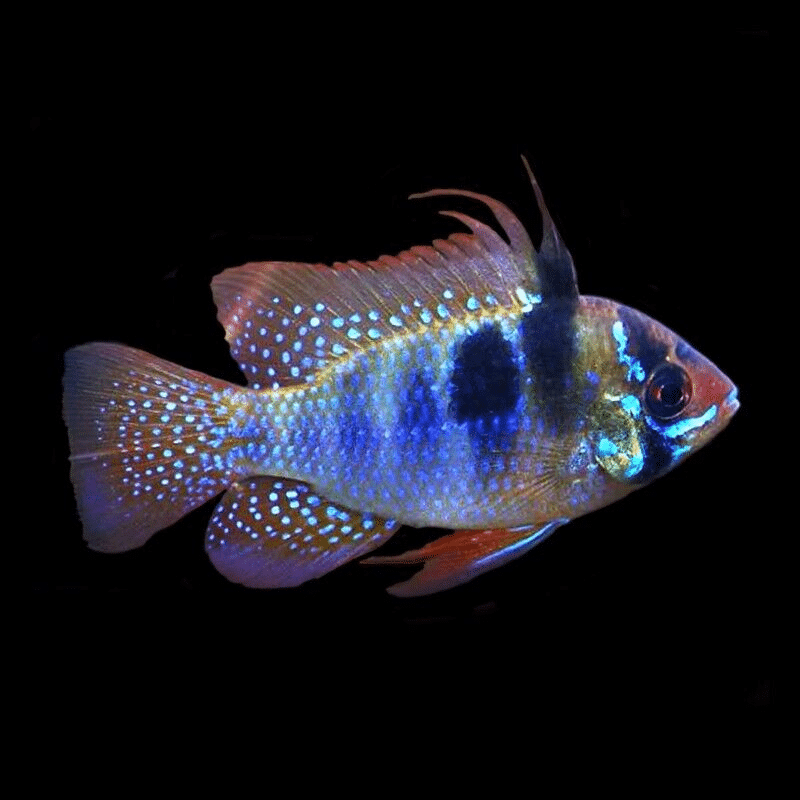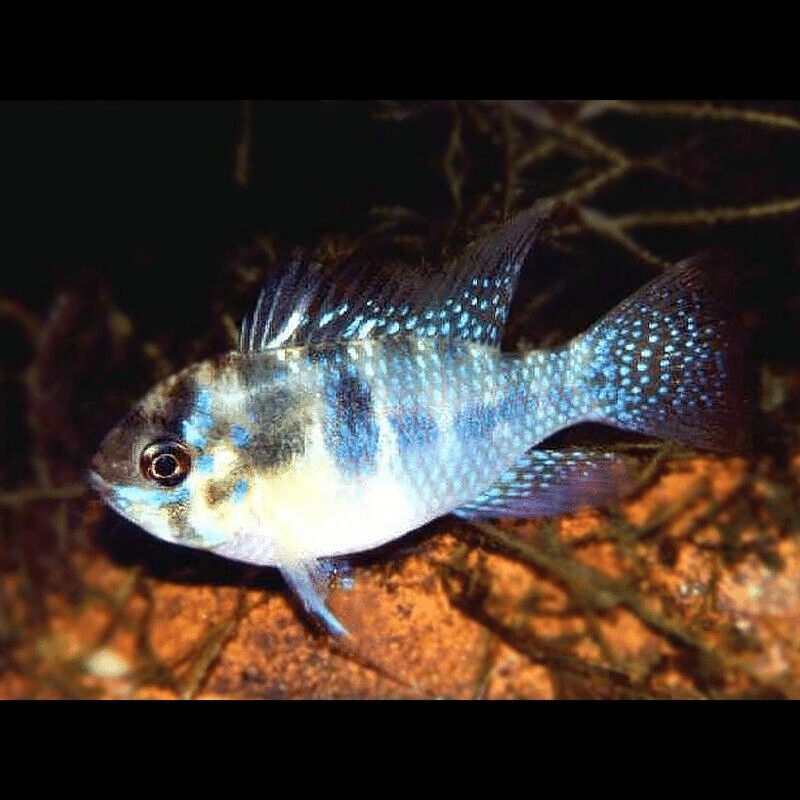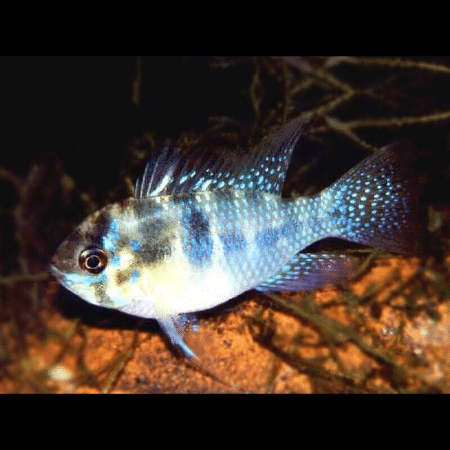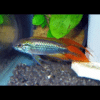Mikrogeophagus Ramirezi «Blue Brilliant» – Papiliochromis – Ram Dwarf Cichlid, Explore the Joy of Caring for This Stunning Tropical Fish and Enhance Your Aquarium’s Aesthetics
£18.49 Original price was: £18.49.£15.48Current price is: £15.48.
Welcome these beautiful Mikrogeophagus Ramirezi «Blue Brilliant» into your aquarium! Their vibrant blue hues and elegant patterns create a stunning visual appeal, making them ideal tropical fish for any community tank. Perfect for beginners seeking peaceful companions for their aquatic environment.
998 in stock
Species Introduction
The Mikrogeophagus Ramirezi, commonly known as the Blue Brilliant Dwarf Cichlid, is a captivating freshwater fish native to the slow-moving waters of the Orinoco River basin in Venezuela and Colombia. This species thrives in warm, soft waters that are rich in organic matter and vegetation, making it a perfect addition to a well-planted aquarium. The vibrant colors and distinctive patterns of the Blue Brilliant Dwarf Cichlid make it a popular choice among aquarists, particularly those looking to create a peaceful community tank. With their gentle nature and stunning appearance, these fish are ideal companions for a variety of other species, contributing to the overall harmony of your aquatic environment.
Care Requirements Dashboard
| Optimal Living Conditions | |
|---|---|
| Water Temperature | 24-27°C (75-81°F) |
| pH Level | 6.5-7.5 |
| Water Hardness | 4-12 dKH |
| Minimum Tank Size | 80L (20 gal) |
| Salinity | Freshwater |
| Care Level | Beginner Friendly |
✓ Care Level: Moderate
Tank Size: Minimum 20 gallons
Water Temperature: 78°F – 86°F (25°C – 30°C)
pH Level: 5.5 – 7.5
Hardness: 2 – 15 dGH
The care requirements for the Mikrogeophagus Ramirezi are essential to ensure their health and well-being. They thrive in a well-maintained aquarium that mimics their natural habitat. A minimum tank size of 20 gallons is recommended to provide ample swimming space and territory. Maintaining a water temperature between 78°F and 86°F is crucial, as they prefer warmer waters. The pH level should be kept between 5.5 and 7.5, with a hardness range of 2 to 15 dGH. Regular water changes and quality monitoring will help maintain a stable environment for these beautiful fish.
Natural Behavior & Temperament
Mikrogeophagus Ramirezi are known for their peaceful disposition, making them excellent candidates for community tanks. They exhibit a variety of natural behaviors, including playful swimming patterns and territorial displays, particularly during breeding. These dwarf cichlids are often seen exploring their environment, foraging among plants and substrate for food. Their social nature allows them to coexist harmoniously with other peaceful fish species, provided that the tank is spacious enough to accommodate their territories. Observing their interactions can be a delightful experience, as they often engage in playful antics and establish social hierarchies within their group.
Tank Setup Guide
Creating an ideal environment for your Mikrogeophagus Ramirezi involves careful consideration of tank setup. Begin with a minimum tank size of 20 gallons, ensuring ample swimming space. A sandy substrate is recommended, as it allows these fish to dig and forage naturally. Incorporate plenty of live plants, such as Java Fern and Anubias, to provide hiding spots and create a naturalistic environment. Additionally, include driftwood and rocks to establish territories and enhance the aesthetic appeal of your aquarium. Proper filtration is essential to maintain water quality, and gentle water movement is preferred to mimic their natural habitat.
Water Quality Management
✓ Good Water Quality: Essential for Health
pH Level: 5.5 – 7.5
Temperature: 78°F – 86°F
Hardness: 2 – 15 dGH
Maintaining optimal water quality is paramount for the health of your Mikrogeophagus Ramirezi. Regular water testing is essential to ensure that pH levels, temperature, and hardness remain within the recommended ranges. Utilize high-quality filtration systems to keep the water clean and clear, and perform regular water changes of 10-20% weekly to remove toxins and replenish essential minerals. Monitoring ammonia, nitrite, and nitrate levels will help prevent harmful spikes that could jeopardize the health of your fish.
Feeding & Nutrition
Feeding your Mikrogeophagus Ramirezi a balanced diet is crucial for their growth, coloration, and overall health. These fish are omnivorous and thrive on a varied diet that includes high-quality flakes, pellets, and frozen or live foods such as brine shrimp and daphnia. A feeding schedule of 2-3 small meals per day is recommended to prevent overfeeding and maintain water quality. It is essential to monitor their feeding habits and adjust portion sizes accordingly to ensure that each fish receives an adequate amount of nutrition without excess waste.
Compatibility Guide
✓ Peaceful Community Fish
Compatible Tank Mates: Tetras, Rasboras, Corydoras, Guppies
⚠ Avoid: Aggressive species like Cichlids
Mikrogeophagus Ramirezi are known for their peaceful temperament, making them suitable for community tanks with other non-aggressive species. Ideal tank mates include Tetras, Rasboras, Corydoras, and Guppies, which share similar water requirements and behavioral traits. However, it is crucial to avoid pairing them with aggressive fish, particularly larger cichlids, as this can lead to stress and territorial disputes. Ensuring a balanced community with compatible species will enhance the overall harmony of your aquarium.
Health & Wellness
Maintaining the health and wellness of your Mikrogeophagus Ramirezi involves regular monitoring and preventive care. Common health issues include ich, fin rot, and stress-related diseases. To prevent these problems, ensure that water quality is consistently high and that the fish are not subjected to aggressive tank mates. Observing their behavior and physical appearance is essential; signs of illness may include lethargy, loss of appetite, or visible lesions. Prompt treatment and isolation of affected fish can prevent the spread of disease within the tank.
Breeding Information
Breeding Mikrogeophagus Ramirezi can be a rewarding experience for aquarists. These fish are known to form strong pair bonds, and breeding typically occurs in a well-planted tank with suitable hiding spots. The female will lay eggs on flat surfaces, such as leaves or rocks, and both parents will guard the eggs diligently. After a few days, the eggs will hatch, and the fry will require special care, including infusoria or finely crushed flakes for initial feeding. Providing a separate breeding tank can help protect the fry from potential threats and ensure their healthy development.
Acclimation Process
Introducing your Mikrogeophagus Ramirezi to their new environment requires a careful acclimation process to minimize stress. Begin by floating the sealed bag containing the fish in the aquarium for about 15-20 minutes to equalize temperature. Afterward, gradually introduce small amounts of aquarium water into the bag over the course of an hour. This method allows the fish to adjust to the new water parameters before being released into the tank. Avoid sudden changes in temperature or water chemistry, as this can lead to shock and health issues.
Long-term Care
The long-term care of your Mikrogeophagus Ramirezi involves regular maintenance and monitoring of their environment. These fish can live for several years when provided with optimal conditions. Regular water changes, consistent feeding schedules, and careful observation of their behavior will help ensure their health and happiness. As they grow, be mindful of their territorial behavior, especially during breeding periods, and be prepared to provide additional space or hiding spots as necessary.
Natural Habitat Recreation
Recreating the natural habitat of the Mikrogeophagus Ramirezi in your aquarium is essential for their well-being. Mimic the slow-moving waters of the Orinoco River by incorporating a sandy substrate, abundant vegetation, and driftwood. Use a variety of live plants to create hiding spots and encourage natural behaviors. The addition of leaf litter can also help replicate their natural environment and provide food for the fish. A well-planned biotope setup not only enhances the aesthetic of your aquarium but also supports the health and happiness of your aquatic companions.
Seasonal Care Adjustments
As seasons change, so do the needs of your Mikrogeophagus Ramirezi. During warmer months, monitor the water temperature closely, as they thrive in warmer conditions. Ensure that the aquarium is not exposed to direct sunlight, which can lead to overheating. In colder months, consider using a heater to maintain a stable temperature. Additionally, adjust the lighting schedule to mimic natural daylight cycles, promoting healthy growth and behavior. Regularly assess water quality and make necessary adjustments to ensure a stable environment throughout the year.
Expert Tips
✓ Professional Advice for Optimal Care
Consider using a sponge filter to maintain gentle water flow.
Provide plenty of hiding spots to reduce stress during breeding.
Regularly monitor water parameters to ensure stability.
To ensure the best care for your Mikrogeophagus Ramirezi, consider implementing these expert tips. Using a sponge filter can help maintain gentle water flow, which is beneficial for their health. Providing ample hiding spots will reduce stress, especially during breeding periods. Regular monitoring of water parameters will help maintain stability and prevent potential health issues. By following these tips, you can create a thriving environment for your aquatic companions.
Troubleshooting
Despite your best efforts, you may encounter challenges while caring for your Mikrogeophagus Ramirezi. Common issues include stress from aggressive tank mates or poor water quality. If you notice signs of stress, such as hiding or loss of appetite, assess the tank environment and consider rearranging decorations to reduce territorial disputes. If health issues arise, such as ich or fin rot, prompt treatment is essential. Isolate affected fish and consult a veterinarian or aquatic specialist for appropriate treatment options.
Scientific Background
The Mikrogeophagus Ramirezi belongs to the family Cichlidae, which is known for its diverse range of species and complex behaviors. This species is particularly noted for its vibrant coloration and unique patterns, which can vary among individuals. Research on the Mikrogeophagus Ramirezi has focused on its breeding behaviors, social structures, and habitat preferences. Conservation efforts are essential to protect their natural habitats, as pollution and habitat destruction pose significant threats to their populations in the wild.
Advanced Care Techniques
For experienced aquarists looking to enhance their care for Mikrogeophagus Ramirezi, consider implementing advanced techniques such as breeding conditioning and specialized feeding regimens. Conditioning pairs for breeding can involve providing high-protein foods and ensuring optimal water conditions. Additionally, utilizing live foods can stimulate natural hunting behaviors and promote healthy growth. Regularly engaging with your fish and observing their behaviors will deepen your understanding and appreciation of these beautiful aquatic companions.
Water Quality Parameters
Optimal Range
24-27°C
6.5-7.5
0 ppm
Caution Zone
22-24°C or 27-29°C
6.0-6.5 or 7.5-8.0
0.25-0.5 ppm
Danger Zone
<22°C or >29°C
<6.0 or >8.0
>0.5 ppm
Monitoring Tip: Test water parameters weekly and perform regular water changes to maintain optimal conditions for your aquatic friends!
Frequently Asked Questions
Q: What tank size is required for Mikrogeophagus Ramirezi?
For Mikrogeophagus Ramirezi, a minimum tank size of 80 litres is recommended. This allows ample space for swimming and territorial behaviour, which is crucial for their wellbeing. A larger tank can help in maintaining stable water parameters, which these fish prefer. When setting up the tank, consider including hiding spots and plants, as they enjoy exploring and feeling secure in their environment. Additionally, the dimensions of the tank should allow for a suitable swimming area, as these fish are active swimmers. Properly establishing a tank with these considerations will lead to a more harmonious environment for your aquatic companions.
✓ Expert Tip
Ensure to regularly monitor water quality and perform routine maintenance to keep the environment stable and healthy.
Q: What water parameters do Mikrogeophagus Ramirezi require?
Mikrogeophagus Ramirezi thrive in soft, slightly acidic water. Ideal parameters include a pH of 6.0 to 7.5, a hardness of 2-10 dGH, and a temperature range of 24-28°C. Maintaining these conditions is vital for their health and colouration. Regular water changes of 20-30% weekly will help in keeping the water quality high and stable. Additionally, using a quality water conditioner can assist in removing harmful chemicals from tap water. Testing kits are essential tools for any aquarium keeper to ensure that these parameters are consistently met.
✓ Expert Tip
Utilising driftwood and plants can help buffer the pH naturally, providing a more suitable environment.
Q: How often should I feed Mikrogeophagus Ramirezi?
Feeding Mikrogeophagus Ramirezi should be done twice daily, providing only what they can consume within a few minutes. A varied diet is essential, including high-quality flakes, pellets, and occasional live or frozen foods such as brine shrimp or daphnia. This variety not only enhances their colouration but also supports their overall health. It’s important to avoid overfeeding, as uneaten food can degrade water quality. Monitor their health and adjust the feeding quantity as necessary, especially during breeding periods when appetite may increase.
✓ Expert Tip
Consider using a feeding ring to prevent food from dispersing and ensure all fish can access it easily.
Q: What are the best tank mates for Mikrogeophagus Ramirezi?
Mikrogeophagus Ramirezi are generally peaceful and can coexist with other similarly sized, non-aggressive fish. Suitable tank mates include tetras, rasboras, and small catfish. It is advisable to avoid larger, more aggressive species that may bully them. When introducing new fish, do so gradually to minimise stress and establish a stable hierarchy. Providing ample hiding spots and territories can help reduce potential conflicts and ensure a harmonious community. Always observe interactions closely, especially during breeding times, as they can become territorial.
✓ Expert Tip
Consider adding more females than males to reduce aggression and enhance breeding success.
Q: How do I properly acclimatise Mikrogeophagus Ramirezi to my aquarium?
Acclimatising Mikrogeophagus Ramirezi is crucial for their adaptation and health. Begin by floating the sealed bag in your aquarium for about 15-20 minutes to equalise the temperature. Then, slowly mix small amounts of aquarium water into the bag every 5 minutes for about an hour. This gradual introduction helps them adjust to the new water chemistry. Finally, gently place them into the tank using a net to avoid introducing excess bag water. Monitor their behaviour closely for signs of stress after introduction.
✓ Expert Tip
Reducing light intensity during the acclimatisation period can help lessen stress.
Q: What are the signs of healthy Mikrogeophagus Ramirezi?
Healthy Mikrogeophagus Ramirezi exhibit vibrant colours, active swimming behaviour, and a healthy appetite. Their fins should be extended, and they should display no signs of distress or unusual behaviour such as hiding excessively or lethargy. Regularly inspecting for any physical abnormalities, such as lesions or discoloration, is also important. A well-maintained environment will contribute significantly to their overall health, so paying attention to water quality and tank conditions is essential for recognising signs of wellbeing.
✓ Expert Tip
Keep a close eye on their behaviour during feeding; a lack of interest can indicate health issues.
Q: How do I successfully breed Mikrogeophagus Ramirezi?
Breeding Mikrogeophagus Ramirezi can be a rewarding experience. Start by ensuring a healthy pair, which can be identified by their behaviour and colouration. Provide a breeding area, such as a flat rock or spawning cone, and maintain optimal water conditions. Once the female lays eggs, both parents will guard the nest. It’s important to separate the pair once the eggs hatch to prevent aggression. Fry should be fed infusoria or finely crushed flakes until they grow larger. Regular water changes are crucial during this period for the health of the fry.
✓ Expert Tip
Keep the breeding tank well-planted, as it provides hiding spots for the fry.
Q: What temperature should I maintain for Mikrogeophagus Ramirezi?
The ideal temperature for Mikrogeophagus Ramirezi ranges from 24°C to 28°C. Maintaining a consistent temperature within this range is crucial for their health and behaviour. Sudden fluctuations can lead to stress and health issues. A reliable aquarium heater with a thermostat is recommended to achieve and maintain the desired temperature. Regular monitoring with a thermometer will help ensure stability. Keeping the tank in a location away from direct sunlight and drafts can also assist in maintaining an even temperature.
✓ Expert Tip
Consider using a heater guard to prevent accidental burns or injuries to your fish friends.
Q: How long do Mikrogeophagus Ramirezi typically live in captivity?
In captivity, Mikrogeophagus Ramirezi can live for approximately 3 to 5 years with proper care. Their lifespan is influenced by factors such as water quality, diet, and tank conditions. Regular maintenance and monitoring of water parameters are essential for promoting longevity. A varied and nutritious diet will also support their health and vitality. Providing a stress-free environment with appropriate tank mates can further enhance their quality of life, allowing them to thrive and live out their full potential lifespan.
✓ Expert Tip
Keep a log of their health and any changes to the environment to assist in identifying issues early.
Q: What type of substrate is most suitable for Mikrogeophagus Ramirezi?
Mikrogeophagus Ramirezi prefer soft substrates such as fine sand or soft gravel, as they enjoy sifting through the substrate in search of food. This mimics their natural habitat and allows them to exhibit natural behaviours. Avoid sharp substrates, as they can injure their delicate fins. A layer of at least 2-3 cm is ideal, allowing them to dig and create small pits. Additionally, incorporating plants into the substrate will provide hiding spots and improve the overall aesthetics of the aquarium.
✓ Expert Tip
Use a substrate vacuum during water changes to maintain cleanliness without disturbing their environment.
Q: What behavioural patterns should I expect from Mikrogeophagus Ramirezi?
Mikrogeophagus Ramirezi are known for their lively and inquisitive nature. They often display social behaviour, swimming in pairs or small groups. During breeding, they can become territorial, particularly around their nesting area. Observing their interactions can reveal their dynamic personality, as they engage in playful chasing and exploring their environment. Providing plenty of hiding spots and open swimming areas encourages natural behaviours and reduces stress, allowing them to thrive in their aquarium setting.
✓ Expert Tip
Incorporate floating plants to provide shade and security, enhancing their comfort and natural behaviours.
Q: How can I prevent common diseases in Mikrogeophagus Ramirezi?
Preventing diseases in Mikrogeophagus Ramirezi involves maintaining excellent water quality, providing a varied and nutritious diet, and ensuring a stress-free environment. Regular water changes and monitoring parameters are key to avoiding issues. Quarantining new fish before introducing them to the main tank can prevent the spread of pathogens. Additionally, avoid overcrowding to reduce stress and competition for resources. Observing your fish regularly for any signs of illness, such as changes in appetite or behaviour, allows for early intervention and treatment.
✓ Expert Tip
Invest in a quality water testing kit to regularly monitor your tank’s parameters.
Q: What lighting conditions do Mikrogeophagus Ramirezi prefer?
Mikrogeophagus Ramirezi thrive in moderate lighting conditions. Bright, direct light may cause stress, so providing shaded areas with plants or decorations is beneficial. A light cycle of around 10-12 hours per day is ideal, allowing for a natural day-night rhythm. Using LED lights can help in creating a visually appealing environment whilst being energy-efficient. Adjusting the intensity of the lighting can also help in accommodating live plants, which in turn supports the health of your fish friends.
✓ Expert Tip
Consider using a dimmer or adjustable lighting to cater to their comfort and the needs of live plants.
Q: How do I recognise stress in Mikrogeophagus Ramirezi?
Signs of stress in Mikrogeophagus Ramirezi can include erratic swimming, hiding excessively, or loss of appetite. They may also display faded colours or clamped fins. Changes in behaviour can indicate poor water quality, unsuitable tank mates, or environmental stressors. Regular observation is essential for identifying these signs early. If stress is suspected, investigate potential causes such as water parameters, tank conditions, or compatibility with other fish. Addressing the underlying issues promptly can help restore their health and wellbeing.
✓ Expert Tip
Create a stress-free environment by providing plenty of hiding spots and maintaining stable water conditions.
Q: What natural habitat conditions should I replicate for Mikrogeophagus Ramirezi?
To replicate the natural habitat of Mikrogeophagus Ramirezi, aim for a soft, sandy substrate with plenty of hiding spots and plants. They originate from slow-moving waters in South America, so incorporating driftwood and natural decor can mimic their environment effectively. Maintaining slightly acidic water with a temperature of 24-28°C will also enhance their comfort. Regularly monitoring the water quality and ensuring proper filtration will help create a healthy ecosystem for these beautiful fish. Providing a stable and well-planted environment promotes their natural behaviours and overall wellbeing.
✓ Expert Tip
Regularly rearranging plants and decor can keep the environment interesting and stimulating for your fish.

















Emily Carter (verified owner) –
I recently added the Mikrogeophagus Ramirezi «Blue Brilliant» to my aquarium, and I couldn’t be more thrilled! These beautiful dwarf cichlids have brought so much life and vibrancy to my tank. After about two months of keeping them, I’ve noticed how they interact with each other and their environment – it’s like watching a little underwater ballet! The colors are truly stunning, with deep blues and yellows that really pop against the green plants.
I keep them in a 20-gallon tank, and they seem to thrive in this space, often swimming among the plants and exploring their territory. Compared to other tropical fish I’ve owned, these Rams have a much more engaging personality and tend to be less shy. While they can be a bit territorial, especially during breeding, I find that their behavior is manageable as long as I provide hiding spots.
I highly recommend these colorful fish for any aquarist, particularly those who appreciate a more interactive aquarium experience. Just ensure your tank is well-planted and has stable water conditions. Overall, I’m delighted with my purchase and would buy them again in a heartbeat!
Emily Carter (verified owner) –
I recently added the Mikrogeophagus Ramirezi ‘Blue Brilliant’ to my 20-gallon aquarium, and I couldn’t be happier! These stunning dwarf cichlids have transformed my tank into a vibrant underwater paradise. Their iridescent blue and yellow colors are absolutely mesmerizing, and they really stand out against the lush greenery in my setup. After just a month, I’ve noticed not only their beauty but also how active and social they are. They explore every corner of the tank and interact with my other fish beautifully, making them a joy to watch.
Compared to other tropical fish I’ve kept, the Ramirezi have such a charming personality and are relatively easy to care for, given they prefer soft, slightly acidic water. However, I’ve found they do need some hiding spots, so I added a few caves and plants, which they love.
If you’re looking for a stunning addition to your aquarium, I highly recommend these dwarf cichlids. They’re perfect for both beginners and experienced aquarists who value fish welfare. Just make sure to keep their environment stable for the best health and happiness. I would definitely buy another pair in the future!